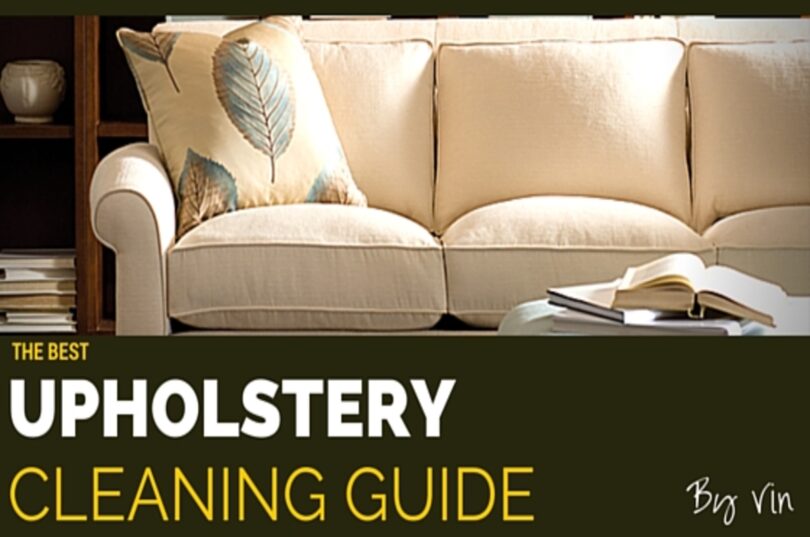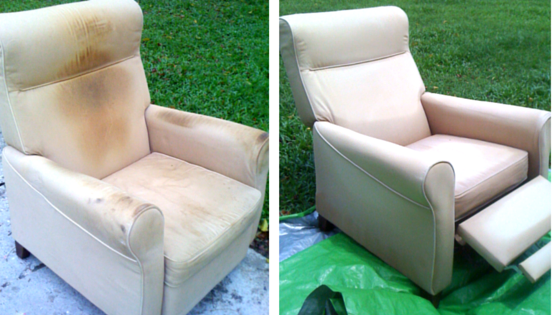The Best Upholstery Cleaning Guide!

Imagine wearing your clothes for months & years without washing or cleaning them. Yucks! You’ll have dead skin, bad odour, bacteria, gems, food particles, spots, stains, fungus and tons of other bad things that could be happening that isn’t quite visible to a naked eye nor welcoming. Many of us often overlook the importance of upholstery cleaning on a weekly or at least on a monthly basis. Resulting in all of the bad unwanted stuffs.
Reason for keeping our furniture clean is not only to make the piece more attractive, but it also lengthens its lifespan immensely. While cleaning a whole house’s worth of furniture at once during our yearly “spring cleaning” can be a nightmare, ill suggest a regular dusting and vacuuming in combination with other cleaning strategies and method that will be covered later in this article that will keep your furniture looking fantastic & in most cases it won’t be much of a hassle when it comes to our annual spring cleaning.
Getting Professional Help

If you haven’t already know, Dks provides an awesome Upholstery Cleaning Service for a relatively low price. If you have a tight budget, lack of time and in need of a company that provides an expert Upholstery Cleaning Service at affordable price, Dks provides the perfect professional cleaning service for you.
However, if you’re a DIY (Do-It-Yourself) type of person, keep reading.
What is Upholstery Cleaning?
Before we dive into all the “how to”s, lets quickly understand what exactly upholstery cleaning is. Upholstery cleaning is basically when you have a great looking furniture but have witness it looking much better in the past. Basically, its just dirty, damaged by negligence, improper daily use or simply just bad weather.
So, does it mean we have to reupholster, recover or even buy a new furniture? No, restoring or buying a new furniture isn’t going to solve your problem of your furniture being damaged so quickly in your home. It also doesn’t mean that you have bad furniture. In fact, sometimes it isn’t about the furniture at all. The fact is that actually the way we maintain our furniture is what determines the life of our furnitures.
So here is a simple straight forward self-help guide to upholstery cleaning with the help of some simple techniques and tools that you could use from now to prevent your furniture from being damaged easily.
Accidents Do Happen! – It’s OKAY!
Upholstery cleaning can be essential in virtually every home because regardless of how carefully you’re taking care of your upholstered furniture accidents do happen, & its okay! You can’t predict accidents but you can however prevent if from seriously damaging your furniture further. So how do you prevent it for damaging your furniture even further? Here are some tips on handling such cases and other similar ones;
✓ Always Vacuum Before Cleaning Your Upholstery!
Vacuuming your upholstery is probably the most crucial part of upholstery cleaning. One of the most common mistake is immediately diving into the ‘’cleaning part’’ of the process. If your upholstery is starting to developed stains, spots or starting to appear dull and aged, keep in mind to vacuum it first before doing anything else. This will basically remove the dust and dirt sitting on your fabric, which when wet could further stain your upholstery.
Tip: Using a upholstery attachment brush while vacuuming can help you better get in the cracks and crevices and thoroughly remove the dust and dirt from your upholstery & cushions.
If you’re unable to use the vacuum to remove your pets fur, try using some Pet Fur Remover Brush or Pet Hair Roller. Try to get rid of as much fur as possible from your upholstery before you start cleaning your upholstery.
✓ Never Scrub Or Rub A Fresh New Spill
A natural way to react whenever we get a fresh spill would be to quickly get just any cloth, scrub or rub the spill to avoid it from soaking further into the fabric. Yes, you should prevent it from soaking further in to the fabric, stuffing, or maybe even the wooden frame. However, you should NEVER scrub or rub a fresh spill.
The the very first thing we suggest you do whenever a spill occurs is to “sponge” the fabric (do not rub or scrub it) with a white fabric/cloth as soon as we can. This is to minimise the spreading of the stain. The whole idea is prevent the spill from spreading into a wider area of the fabric.
✓ Never Use Just Any Upholstery Cleaner of The Rack
There are hundreds maybe thousands of products out there that are made to clean your upholstery. But every furniture is unique in its own way. There are mainly 2 things your furniture cleaning kit should depend on;
1) Type of fabric on your furniture
2) Type of stain/spot you’re cleaning
You may wish to check the fabric cleaning instruction label attached to your furniture or contact your supplier or an expert. While purchasing the upholstery cleaning kit always lookout for instructions on what type of stains and spots its best suited for. Hence, never use just any upholstery cleaner of the rack.
✓ Understanding Washing Labels & Cleaning Codes
We have been talking so much about washing labels and the cleaning codes. So where can we usually find these cleaning codes and how we can understand them? Cleaning codes can be found on washing labels which are typically found in a hidden area at the back or hanging in an inconspicuous place on the side of the furniture, or under seat cushions.
Cleaning codes on washing labels were created mainly to give proper care instruction for each fabric specifically. Here are some typical codes you may find;
☑ W: Clean the upholstery fabric with a water based detergent.
☑ S: Clean the upholstery fabric with a water free product. Such as sprays and powders.
☑ WS: Clean the upholstery fabric with either a water based or a water free cleaner, depending on the type of stain. (The best type of cleaner to purchase)
☑ X: This upholstery fabric must be professionally cleaned. You should only vacuum and brush it — never use any type of upholstery cleaner on it yourself. (always seek professional help)
However, if your furniture doesn’t have a washing label or cleaning tags you can apply some other techniques we talk about in the next tab to solve that issue.
✓ Cleaning Upholstery Without Washing Labels & Codes
It’s very normal to find missing washing labels and cleaning tags on your furniture. It happens all the time. It’s also completely fine to proceed with your cleaning. However, there are a few extra precaution to take when cleaning without proper instructions given by the washing labels from our furniture. Here are some;
☑ Identify your fabric, pick the right upholstery cleaning product that suits your fabric.
☑ Always test your upholstery cleaner/stain remover in an inconspicuous area first.
☑ While testing the product, make sure the fabric maintain its colour without fading.
☑ Start with the most conservative cleaning method & proceed cautiously from there.
If you’re having difficulties with your upholstery or want to be especially cautious and are not familiar with the process of cleaning, it’s always better to contact us.
Our 3 Steps Self-Cleaning Guide
Step 1 : The Preparation
Vacuums aren’t just made for cleaning floors and carpets. After purchasing our vacuum we often overlook those tiny incredibly important accessory that comes along with it. Yes, that tiny brush attachment the other vacuum accessory is really important. It works really well with upholstery cleaning.
✓ Use that brush attachment & vacuum your upholstery along with your other soft furnishing around your home on a weekly basis. The other “angle-tipped” tool is awesome for those hard to reach sneaky, where the “dirt, dust & oil usually are. Areas such as; creases, fabric folds and other tufted areas.
✓ Once every month, try to take your cushions out in the sun and beat them with some hard object or just by hand. This helps prevent dust from settling into your cushion’s fibers. After you’re done with that, always rotate and flip the cushions as you would to a mattress ensure even wear
Step 2 : Treatments For Stains
Do food, drinks & pets only cause stains? Nope. There are less obvious sources of stains that many of us aren’t away off. These can be our clothing and even newspaper ink could possibly bleed onto our fabric. Always avoid keeping any ink related materials your upholstery.
✓ The number one rule of attending to a spill is to get to it as quickly as you can before it spreads or sets into the fabric. Never use just any cloth, always a clean white cloth, fabric or a paper towel. With that said, use a blotting or sponging motion (pressing it up and down) on the stain. NEVER rub or scrub any spill, it will only spread it into a larger area and make it worst. One of the most effective methods used by the cleaning pros and us is called “Blossoming”. We basically start from the outside of the stain towards the center. “Blot it Dry”
✓ Should the “Blotting” technique not work, another advance cleaning method will be required. Quickly find the manufacturing care label somewhere down below, at the back or along the side of your sofa. On the label you’ll find some care instructions and some code, which are called “cleaning code”. It simply tells you which type of cleaning product can be used to clean your particular fabric. “W” for water-based cleaners, “S” for dry-cleaners such as powder and sprays, “WS” for either and “X” for none of the above – In which, vacuuming or calling the experts is your only option.
Note: Many grease or oil-based stains (gravy, butter, cosmetics) are only treatable with dry cleaning products.
Step 2 : Treatments For Stains (ADVANCE)
Should the basics not work, you can try the advance cleaning method. We recommend not trying any of these if you don’t know what you’re doing. If you’re confident, it’s always wise to test the colorfastness of the fabric you’re using on an inconspicuous area of the furniture. Apply the solutions over a clean white fabric/cloth and press it down against the area you’re testing for about 30 – 45 seconds. Closely examine the area for any colour fading.
✓ Whether you decide to go with a pH-balanced (neutral) detergent in a 1:20 type water/mixture solution or a commercial dry cleaning solution that you bought always finish by blotting with clean water.
✓ Never over-wet the fabric while cleaning. Using too much water or cleaning solution can spread the stain saturate the sponge/padding underneath the upholstery, creating the perfect haven for mould, mildew and bacteria – all of which are far worse than a surface stain.
Note: Never try to speed things up by drying it with a hot hair dryer or putting it in direct sunlight – heat merely sets the stain. Instead, merely blot the area dry patiently.
Step 3 : The Deep Maintenance
Schedule your soft furnishing for a deep cleaning once every year. If you’re using loose covers for your soft furnishing you have an advantage as removing and washing them isn’t much of a problem (Check washing-care label for instructions before washing). It’s advisable to turn them inside out and wash in cold water to prevent fading. Loose covers are very unlikely to be machine dried, so try drying it naturally.
✓ If your loose covers are labeled as “dry clean only” we strongly encourage you to contact us instead. Giving it to the professional for cleaning will ensure any fading or color variation. It also helps your fabric color to stay consistent throughout all matching fabric.
✓ If you’re NOT using loose covers and are using fixed upholstery instead don’t hesitate to consult professional at least once a year. You should also call a professional if you have a large volume-spill over your soft furnishing. Large volume spills could easily damage the sponge/padding and other part inside your furniture. Always be cautious.
Maintaining your furniture regularly using these method will not only lengthen your furniture’s lifespan, it will also keep it looking cleaning, smelling good and free from bacteria and germs. As mentioned earlier the importance of upholstery cleaning is essential for us and our family. Try out these techniques that us experts and professional use and let us know what you think. Leave a comment below if you have any questions relating to Upholstery Cleaning and also any other matter relating to home improvement services and products.
